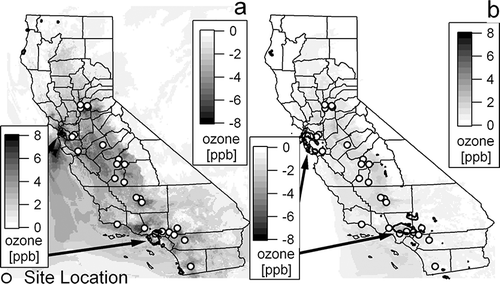Figures & data
Table 1. Key rate constant or photolysis rate changes relative to SAPRC99a
Figure 1. (a) Difference in mean daily maximum 8-hr O3 concentration for predictions with SAPRC99 and SAPRC07C, (b) mean daily 8-hr maximum O3 concentration for predictions with SAPRC07C. Comparison sites are indicated by markers or numbers. Numbers (1–6) correspond to sites (left–right) in and : 1 = FLN, 2 = LIVR, 3 = PLR, 4 = ARV, 5 = RUBI, and 6 = ALPN (see for site descriptions).
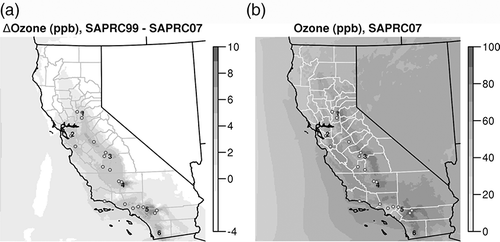
Figure 2. Hourly concentration predictions for simulations with SAPRC07C compared with those for SAPRC99. Columns (left–right) correspond to numbered sites (1–6) in .
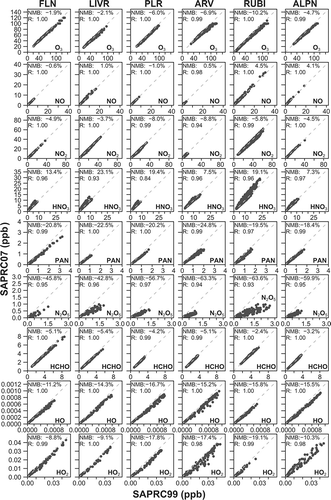
Figure 3. Mean diurnal concentration profiles for simulations with SAPRC07C and SAPRC99. Columns (left–right) correspond to numbered sites (1–6) in . Hour 0 corresponds to 12:00 A.M. PST.
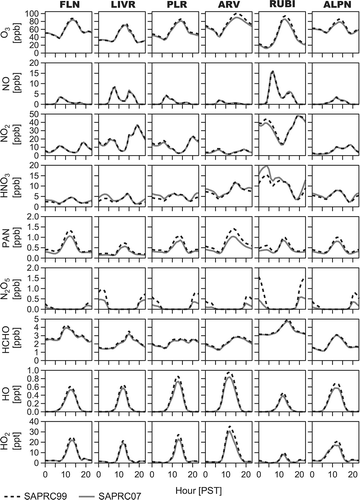
Table 2. Site locations and averaged VOC/NOx (ppbC/ppb) ratios for daytime hours from 10:00 a.m. to 5:00 p.m. (PST)
Table 3. Summary statistics for O3 predictions based on SAPRC07C compared with those based on SAPRC99 at 25 sites in California
Figure 4. (a) Scatterplots of O3 vs. ln(VOC/NOx) for 180 sites for SAPRC99 and SAPRC07C. (b) Scatterplots of normalized O3 difference 100% × (O3,SAPRC07C - O3,SAPRC99)/O3,SAPRC99 vs. ln(VOC/NOx). (c) Scatterplot of OPE vs. ln(VOC/NOx). (d) Scatterplot of normalized OPE difference 100% × (OPESAPRC07C - OPESAPRC99)/OPESAPRC99 vs. ln(VOC/NOx). Note: O3 and VOC/NOx are averaged over daytime hours from 10:00 a.m. to 5:00 p.m. for each site. VOC/NOx values are from the SAPRC99 simulation. OPE is the slope of O3 vs. NOz regression for the hours from 10:00 a.m. to 5:00 p.m. at each site. Only the sites with O3 vs. NOz R [H11022] 0.7 are considered for panels c and d.
![Figure 4. (a) Scatterplots of O3 vs. ln(VOC/NOx) for 180 sites for SAPRC99 and SAPRC07C. (b) Scatterplots of normalized O3 difference 100% × (O3,SAPRC07C - O3,SAPRC99)/O3,SAPRC99 vs. ln(VOC/NOx). (c) Scatterplot of OPE vs. ln(VOC/NOx). (d) Scatterplot of normalized OPE difference 100% × (OPESAPRC07C - OPESAPRC99)/OPESAPRC99 vs. ln(VOC/NOx). Note: O3 and VOC/NOx are averaged over daytime hours from 10:00 a.m. to 5:00 p.m. for each site. VOC/NOx values are from the SAPRC99 simulation. OPE is the slope of O3 vs. NOz regression for the hours from 10:00 a.m. to 5:00 p.m. at each site. Only the sites with O3 vs. NOz R [H11022] 0.7 are considered for panels c and d.](/cms/asset/11c571cd-fdd7-4361-8e70-2f851072e1fe/uawm_a_10412122_o_f0004g.gif)
Figure 5. IC in a uniform O3 concentration of 75 ppb as a result of (a) 20% reduction in NOx and (b) 20% reduction in VOC emissions for the SAPRC99 mechanism (see Equationeq 1 for the definition of IC).
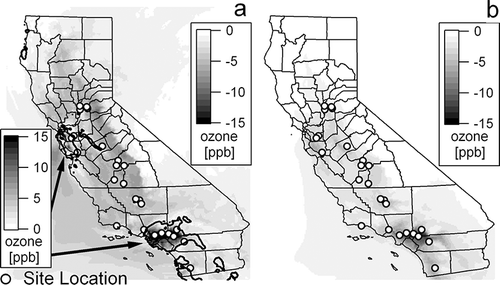
Table 4. Ratio of simulated average daily maximum 8-hr O3 between the 20% emission reduction and base case simulations for the SAPRC99 and SAPRC07C mechanisms
Figure 6. Comparison of the ratios of simulated average daily maximum 8-hr O3 between the 20% NOx emission reduction and base case simulation for the SAPRC99 and SAPRC07C mechanisms. Case 1: SAPRC99 ratio [H11349] 1 and SAPRC07C ratio [H11349] 1; case 2: SAPRC99 ratio [H11022] 1 and SAPRC07C ratio [H11022] 1; case 3: SAPRC99 ratio [H11021] 1 and SAPRC07C ratio [H11022] 1.
![Figure 6. Comparison of the ratios of simulated average daily maximum 8-hr O3 between the 20% NOx emission reduction and base case simulation for the SAPRC99 and SAPRC07C mechanisms. Case 1: SAPRC99 ratio [H11349] 1 and SAPRC07C ratio [H11349] 1; case 2: SAPRC99 ratio [H11022] 1 and SAPRC07C ratio [H11022] 1; case 3: SAPRC99 ratio [H11021] 1 and SAPRC07C ratio [H11022] 1.](/cms/asset/3acf92d8-6099-4195-a1bd-7f16540d2a30/uawm_a_10412122_o_f0006g.gif)
Figure 7. Difference in the IC in O3 between the SAPRC99 and SAPRC07C mechanisms in response to (a) 20% NOx or (b) 20% VOC emissions reductions on the basis of a uniform O3 concentration of 75 ppb (ICSAPRC99 - ICSAPRC07) (see Equationeq 1 for the definition of IC).
